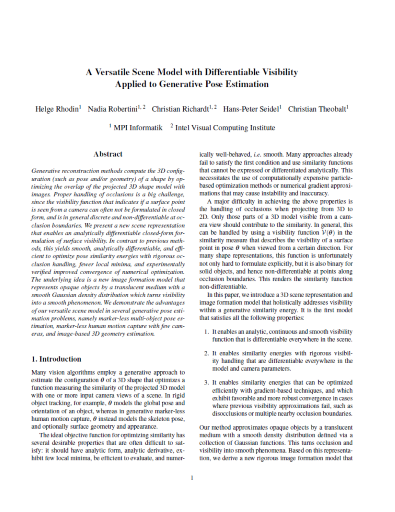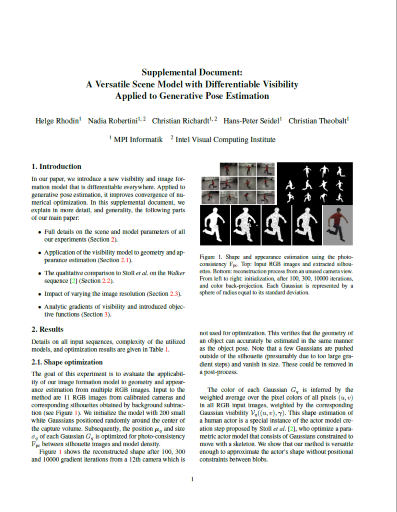ICCV 2015 |
||
A Versatile Scene Model with Differentiable Visibility Applied to Generative Pose Estimation |
| Helge Rhodin1 | Nadia Robertini1,2 | Christian Richardt1,2 | Hans-Peter Seidel1 | Christian Theobalt1 |
| 1MPI für Informatik | 2Intel Visual Computing Institute |
 |
| Abstract | |
Generative reconstruction methods compute
the 3D configuration (such as pose and/or geometry) of a shape by optimizing the overlap of the projected 3D shape model with images.
Proper handling of occlusions is a big challenge, since the visibility function that indicates if a surface point is seen from a camera can often not be formulated in closed form, and is in general discrete and non-differentiable at occlusion boundaries.
We present a new scene representation that enables an analytically differentiable closed-form formulation of surface visibility.
In contrast to previous methods, this yields smooth, analytically differentiable, and efficient to optimize pose similarity energies with rigorous occlusion handling,
fewer local minima,
and experimentally verified improved convergence of numerical optimization.
The underlying idea is a new image formation model that represents opaque objects by a translucent medium with a smooth Gaussian density distribution which turns visibility into a smooth phenomenon.
We demonstrate the advantages of our versatile scene model in several generative pose estimation problems, namely marker-less
multi-object pose estimation, marker-less human motion capture with few cameras, and image-based 3D geometry estimation.
|
Files |
 |
 |
||||
|
Paper PDF (4 MB) |
Supplemental Material PDF (1 MB) |
Presentation |
|
Supplemental Video MP4 (85 MB) |
Spotlight Video MP4 (31 MB) |
Bibtex |
@inproceedings{Rhodin:2015,
author = {Rhodin, Helge and Robertini, Nadia and Richardt, Christian and Seidel, Hans-Peter and Theobalt, Christian}
title = {A Versatile Scene Model with Differentiable Visibility Applied to Generative Pose Estimation},
booktitle = {Proceedings of the 2015 International Conference on Computer Vision (ICCV 2015)},
year = {2015},
url = {http://gvv.mpi-inf.mpg.de/projects/DiffVis}
}
|